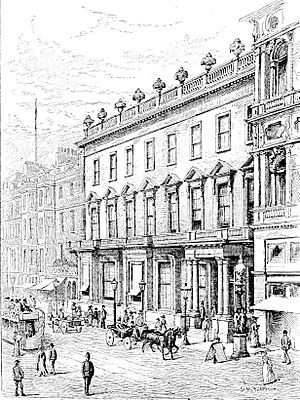New Club, Edinburgh facts for kids
The New Club is a special private club in Edinburgh, Scotland. It's located in the beautiful New Town area. This club is super old! It started way back in 1787, making it the oldest club in Scotland.
The club has moved a few times. From 1809 to 1837, it was in St Andrew Square. Then, it moved to a building made just for the club on Princes Street. This old building was later replaced with a cool, modern one designed by Reiach and Hall. This new building is so important that it's protected as a special "category A listed building." Girls and women were first allowed to join in 1970. They could become full members starting in 2010.
Contents
Club History: How It Started
The New Club began on February 1, 1787. The idea came up just three weeks earlier at a big dance. This dance was called the Caledonian Hunt Ball. It took place at the New Assembly Rooms on George Street.
Early Homes of the Club
The club first met at Bayle’s Tavern. This tavern was on Shakespeare Square. That area was later taken down in the early 1800s. After the owner, Jean Bayle, passed away in 1802, the club looked for a new home. They decided to buy a property in St Andrew Square.
Before moving to St Andrew Square, the club stayed for a short time at Fortune’s Tontine Tavern. Finally, in August 1809, they found their new home at 3 St Andrew Square.
Moving to Princes Street
Later, the club bought two buildings on Princes Street. These were numbers 84 and 85. They were rebuilt and redesigned by William Burn. The club moved into this new building on May 15, 1837. This was the first time old houses in James Craig's New Town were taken down to build something new on Princes Street.
The building became bigger in 1859. This expansion was designed by David Bryce. Over the years, the inside of the club changed a lot. A big change was the dining room. It was rebuilt between 1908 and 1912. The club wanted to make it larger and brighter. Sir Robert Lorimer helped make the room bigger. New windows were added, and the walls were covered with oak wood panels. These panels had portraits inside them.
Modern Changes and New Members
Prince Philip, Duke of Edinburgh became a special supporter of the club in 1952. He held this role until he passed away in 2021. In 2012, a large window was put in the club's entrance. This marked his 60 years as a supporter. It also celebrated the Queen's Diamond Jubilee.
In 1953, the New Club joined with the University Club. Many changes and new decorations were made. The club was completely rebuilt in the 1960s. This modern design was by Alan Reiach, Eric Hall, and their team. The new building included a special area for ladies. It had a Ladies' Bar, a Ladies’ Drawing Room, and a Ladies’ Dining Room. An insurance company paid for the rebuilding. In return, they got to rent the shops below the club for 125 years. The club used the St Andrew’s Hotel as a temporary home while their Princes Street building was rebuilt. When the new building was finished, the club put the original Lorimer wood panels back into the new Dining Room. The new clubhouse opened on December 15, 1969.
Ladies were first allowed to join as Associate Members on March 25, 1970. At first, only wives of members could join. But in October 2010, ladies could become full members. Then, their husbands could join as Associate Members.
The New Club Building: A Special Place
The buildings at 84–87 Princes Street, which include the New Club, are very important. They were listed by Historic Scotland on March 18, 1996. They are a "category A listed building." This means they are of national or international importance for their architecture.
Historic Scotland says the New Club building is the best example of a "Princes Street Panel building." The front of the building, facing Princes Street, is made with large glass panels and Rubislaw granite. It has cool parts that stick out, called "cantilevered sections." This design is described as "very carefully composed." The New Club building is one of about 60 buildings in Edinburgh built after World War II that are listed as category A.
See also
- DoCoMoMo Key Scottish Monuments
- List of Category A listed buildings in the New Town, Edinburgh
- List of post-war Category A listed buildings in Scotland
- Prospect 100 best modern Scottish buildings



